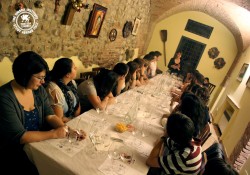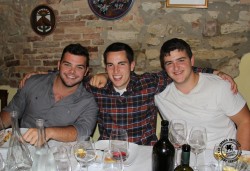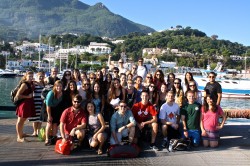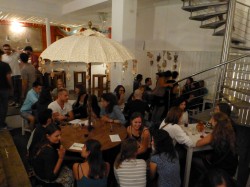Earlier this semester, students enrolled in STFS 330 Sustainability and Food Production in Italy had the opportunity to meet world famous butcher, Dario Cecchini, at his butcher shop in Panzano in Chianti. This small Tuscan town is two hours from Perugia and provides breathtaking views of the surrounding, rolling countryside.
Crowding into Dario’s butcher shop, students and Sunday shoppers alike were greeted by blaring AC/DC music and trays of spiced salami and bread drizzled with olive oil and Dario’s specialty sea salt concoction. Taking a break from his work, Dario spoke to the students about his sustainability philosophy and his ‘whole cow approach.’
“This butcher shop has been in my family for 250 years. Growing up, we ate what was left over from the butcher shop, using peasant recipes to turn the “left-over” cuts into delicious recipes. Nothing was wasted and this is the philosophy that I follow today, that’s sustainability,” explained Cecchini.
His animals live long lives, graze in open land in Spain, and are treated humanely. While he could raise them in Italy, it is actually more sustainable and healthier for the animal to be raised overseas in open fields, as opposed to the confines of a crowded, fenced-in pen, eating manufactured grain. His cows are slaughtered in Spain, by butchers he personally trained, and then transported to Panzano in Chianti for butchering. Honoring the slaughtered animal, every part – from muzzle to tail – is then used as an ingredient in one of his recipes.
This field trip provides an opportunity to reinforce themes previously discussed in the classroom and encourages students to consider foods’ origin, in conjunction with sustainable and traditional food practices.

Following the shop visit and a hike through Chianti vineyards, students were able to taste Dario’s ‘whole cow approach’ in Ristorante Solociccia (“Only Meat”), one of his renowned local restaurants. Collaborating with the restaurant’s chef, menu items are crafted from what the butcher shop has at the moment, allowing for fresh, original dishes. The full menu included a muzzle broth with fresh vegetables for dipping, spicy ragù on toast, roast beef with rosemary potatoes, a boiled meat and vegetable salad, and a raw meatball, flash seared on the outside and served warm. Platter after platter was passed around the table as students wrapped up an educational visit with an excellent meal and good conversation.













